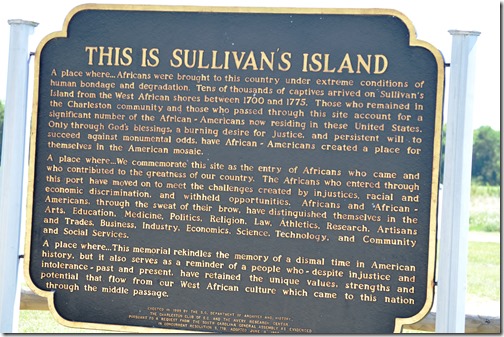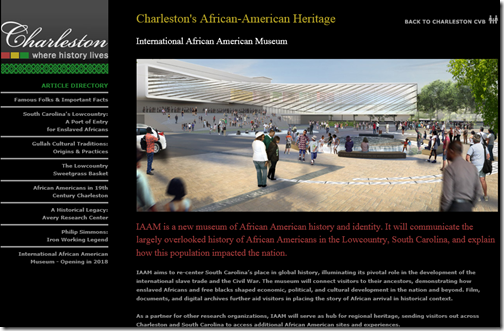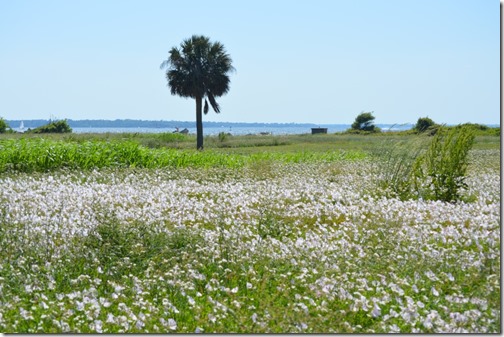There are no large national monuments or even a small sculpture on Sullivan’s Island, South Carolina in memory of the captive West African slaves who passed through this primary gateway of the Middle Passage into the American colonies from 1707 to 1799. Charleston, South Carolina was the wealthiest city in the American Colonies in the 1700s with revenue generated on the export of labor intensive crops like rice, indigo and sea island cotton. It is estimated that in the 1700s, the height of the slave trade, some 40% of West African slaves entered the Colonies through Low Country ports surrounding Charleston.
[Update June 12: The first sentence of this article is not exactly accurate. See the comments to learn about the Toni Morrison Bench Project which began with a bench on Sullivan’s Island July 26, 2008. This bench is a small monument to the African American experience on Sullivan’s Island.]
Sullivan’s Island Pest Houses Historians estimate that around 260,000 African slaves on 882 ships came through Charleston Harbor. Most of these slaves experienced a quarantine period at Sullivan’s Island at the northern approach of Charleston Harbor. The island was used as a quarantine station to hold slaves on ships or in ‘pest houses’ until it was determined the men and women were fit for slave auctions in Charleston. In the 1790s, residents of Sullivan’s Island demanded the pest houses be removed. James Island on the southern side of Charleston Harbor became the new home for quarantine pest houses.
The importation of African slaves was prohibited in the United States beginning in 1808, however, Charleston, South Carolina was the primary slave auction market in the United States for intra-state sales until the end of the Civil War. South Carolina had about 75,000 slaves in 1770 and over 100,000 slaves in 1790. Charleston County in 1790 had three times the number of slaves compared to the white population of 12,000. By 1860, some 400,000 slaves lived in South Carolina, about 10% of the total slave population in the USA.
Why is Sullivan’s Island not a place I ever heard of until last month? I taught American History for several years in public schools and I don’t ever recall seeing the name Sullivan’s Island, South Carolina in the context of slavery in America. There are no monuments on the island to represent the significance of this island to the slave experience. If not for a sign placed in 1990 and a small exhibit at the Fort Moultrie Visitor Center created in 2009, the significance of Sullivan’s Island would have likely gone unnoticed by me during my days visiting Charleston.
This is Sullivan’s Island
There is simply one sign erected by the side of the road in a parking lot for visitors to Fort Moultrie on Sullivan’s Island, a part of Fort Sumter National Monument. That sign was erected in 1990, after two centuries and many memories had forgotten our social history as a nation.
This is Sullivan’s Island
A place where…Africans were brought to this country under extreme conditions of human bondage and degradation. Tens of thousands of captives arrived on Sullivan’s Island from the West African shores between 1700 and 1775. Those who remained in the Charleston community and those who passed through this site account for a significant number of the African-Americans now residing in these United States. Only through God’s blessings, a burning desire for justice, and persistent will to succeed against monumental odds, have African-Americans created a place for themselves in the American mosaic.
A place where…We commemorate this site as the entry of Africans who came and who contributed to the greatness of our country. The Africans who entered through this port have moved on to meet the challenges created by injustices, racial and economic discrimination, and withheld opportunities. Africans and African-Americans, through the sweat of their brow, have distinguished themselves in the Arts, Education, Medicine, Politics, Religion, Law, Athletics, Research, Artisans and Trades, Business, Industry, Economics, Science, Technology and Community and Social Services.
A place where…This memorial rekindles the memory of a dismal time in American history, but it also serves as a reminder for a people who – past and present, have retained the unique values, strength and potential that flow from our West African culture which came to this nation through the middle passage.
Erected in 1990 by the S.C. Department of Archives and History. The Charleston Club of S.C. and the Avery Research Center.
Pursuant to a request from the South Carolina General Assembly as Evidenced in concurrent resolution S. 719, Adopted June 3, 1990.
International African American Museum
The times are a-changin’ and in 2017 there will be the new International African American Museum to serve as a Charleston hub for the regional heritage of African Americans and place the story of African arrival in its historical context.
80% of African-Americans have an ancestor who came through Charleston, SC.
The International African American Museum will be a vital educational resource for Charleston, South Carolina in representing a history of the Low Country visitors should know.
Sullivan’s Island, South Carolina May 8, 2014





4 Comments
Comments are closed.